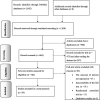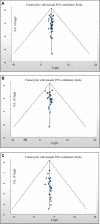Prevalence of knowledge, attitudes, and practices regarding antimicrobial resistance in Africa: a systematic review and meta-analysis
- PMID: 38585703
- PMCID: PMC10996921
- DOI: 10.3389/fmicb.2024.1345145
Prevalence of knowledge, attitudes, and practices regarding antimicrobial resistance in Africa: a systematic review and meta-analysis
Abstract
Background: One of the main threats to public health today is antibiotic resistance. This resistance leads to the persistence of infections in the body. It poses an increased risk of transmission to humans and animals through various routes, such as food, water, and the environment.
Objectives: This study aimed to ascertain the overall prevalence of knowledge, attitudes, and practices regarding antimicrobial resistance in Africa.
Methods: A systematic review and meta-analysis of published and unpublished studies was conducted in Africa according to the Preferred Reporting Items for Systematic Reviews and Meta-Analyses (PRISMA) guidelines. Searches were conducted using appropriate search terms in PubMed, Web of Science, Science Direct, Google Scholar, African Journals Online, and the Cochrane Library. Data were extracted using Microsoft Excel, and STATA version 14 was used for analysis. Publication bias was checked by funnel plot, Egger, and Begg regression tests. A p-value of 0.05 was regarded to indicate potential publication bias. Using I2 statistics, the heterogeneity of the studies was evaluated. Using forest plots, the random effect model was used to present the pooled prevalence with a 95% confidence interval (CI) of meta-analysis.
Results: This review included 39 studies, with 18,769 study participants. Among these 39 studies, 38 were on knowledge assessment, 28 on attitude assessment, and 25 on good practice assessment towards antimicrobial resistances. The overall pooled prevalence level of knowledge regarding antimicrobial resistance in Africa was 55.33% (95% CI: 47.48, 63.18). The overall pooled prevalence of positive attitudes toward antimicrobial resistance in Africa was 46.93% (95% CI: 35.10, 58.76), and the overall pooled prevalence of good practice of antimicrobial resistance in Africa was 51.05% (95% CI: 45.24, 56.87). In addition, sub-group statistical analysis was performed in this meta-analysis, stratified by population sub-region and study design types.
Conclusion: In Africa, the pooled prevalence of knowledge, attitudes, and practices regarding antimicrobial drug resistance among different groups, including the general population, patients, tertiary school students, healthcare workers, and animal owners was found to be low level. Therefore, it is imperative to enhance the education and training programs regarding antibiotic resistance for various groups including the general public, patients, students, healthcare workers, and individuals responsible for the well-being of animals.
Keywords: Africa; antimicrobial resistance; attitude; knowledge; meta-analysis; practice; prevalence; systematic review.
Copyright © 2024 Atalay and Abebe Gelaw.
Conflict of interest statement
The authors declare that the research was conducted in the absence of any commercial or financial relationships that could be construed as a potential conflict of interest.
Figures





Similar articles
-
Knowledge and factors associated with active management of the third stage of labor in sub-Saharan Africa: A systematic review and meta-analysis.Int J Gynaecol Obstet. 2024 Sep;166(3):943-953. doi: 10.1002/ijgo.15560. Epub 2024 May 3. Int J Gynaecol Obstet. 2024. PMID: 38700065
-
A systematic review and meta-analysis of antimicrobial resistance knowledge, attitudes, and practices: Current evidence to build a strong national antimicrobial drug resistance narrative in Ethiopia.PLoS One. 2023 Jun 9;18(6):e0287042. doi: 10.1371/journal.pone.0287042. eCollection 2023. PLoS One. 2023. PMID: 37294747 Free PMC article.
-
Global knowledge, attitudes, and practices towards antimicrobial resistance among healthcare workers: a systematic review and meta-analysis.Antimicrob Resist Infect Control. 2025 May 13;14(1):47. doi: 10.1186/s13756-025-01562-1. Antimicrob Resist Infect Control. 2025. PMID: 40361230 Free PMC article.
-
Knowledge, attitude, practice and associated factors of oxygen therapy among health professionals in Ethiopia: A systematic review and meta-analysis.PLoS One. 2024 Sep 6;19(9):e0309823. doi: 10.1371/journal.pone.0309823. eCollection 2024. PLoS One. 2024. PMID: 39240945 Free PMC article.
-
Health care providers`attitude and associated factors to safe abortion in Ethiopia, 2023: A systematic review and meta-analysis.PLoS One. 2024 Sep 17;19(9):e0308419. doi: 10.1371/journal.pone.0308419. eCollection 2024. PLoS One. 2024. PMID: 39288144 Free PMC article.
Cited by
-
A survey of knowledge and attitudes towards antibiotic use and resistance among teachers in the Republic of Kenya: Implications for using teachers in raising public awareness of rational antibiotic use in school communities.PLoS One. 2024 Dec 23;19(12):e0316122. doi: 10.1371/journal.pone.0316122. eCollection 2024. PLoS One. 2024. PMID: 39715242 Free PMC article.
-
Status and implications of the knowledge, attitudes and practices towards AWaRe antibiotic use, resistance and stewardship among low- and middle-income countries.JAC Antimicrob Resist. 2025 Mar 25;7(2):dlaf033. doi: 10.1093/jacamr/dlaf033. eCollection 2025 Apr. JAC Antimicrob Resist. 2025. PMID: 40134815 Free PMC article. Review.
-
Epidemiology of clinical antimicrobial-resistant Enterobacterales in Togo over three decades: a systematic review and meta-analysis, with recommendations and alternative solutions.BMC Infect Dis. 2025 Apr 29;25(1):632. doi: 10.1186/s12879-025-11035-w. BMC Infect Dis. 2025. PMID: 40301735 Free PMC article.
References
-
- Adegbite B. R., Edoa J. R., Schaumburg F., Alabi A. S., Adegnika A. A., Grobusch M. P. (2022). Knowledge and perception on antimicrobial resistance and antibiotics prescribing attitude among physicians and nurses in Lambaréné region, Gabon: a call for setting-up an antimicrobial stewardship program. Antimicrob. Resist. Infect. Control 11:44. doi: 10.1186/s13756-022-01079-x, PMID: - DOI - PMC - PubMed
-
- Africa CD . Africa CDC framework for event-based surveillance. Interim version (2018)
Publication types
LinkOut - more resources
Full Text Sources

